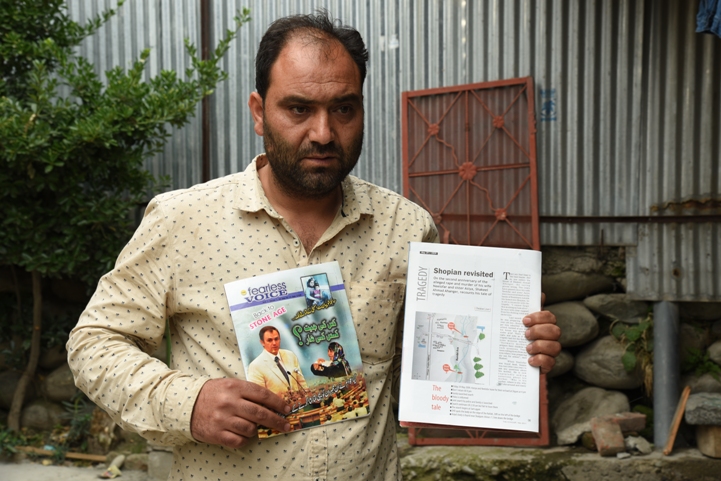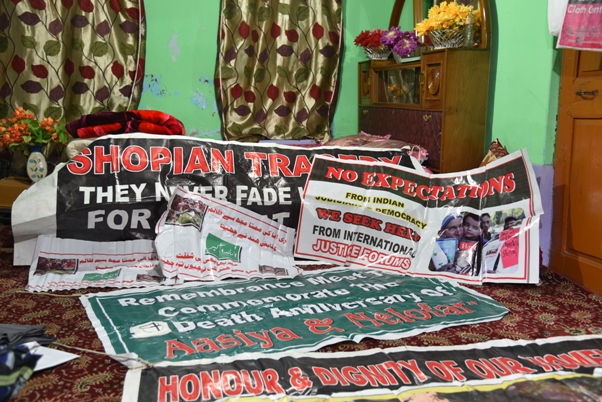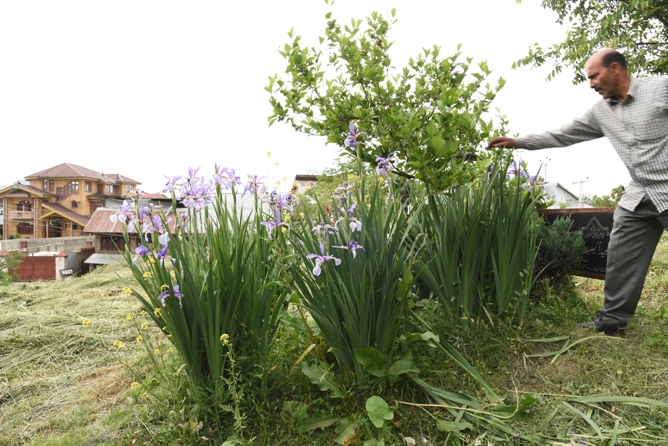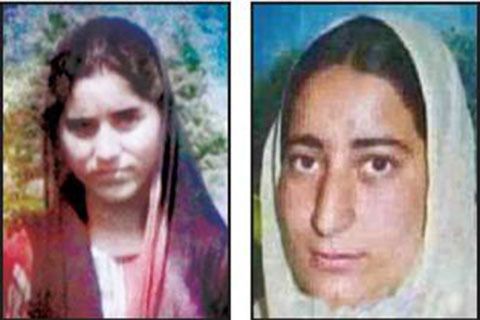Introduction: In the collective memory of the Indian state, the rape of an eight-year-old has already been relegated to the back pages of newspapers, if at all mentioned anywhere. Her name no longer enrages us, and justice to her family no longer occupies any role in our conversations. But what about the people of Kashmir? A region in turmoil for decades remembers Kathua, just as it remembers Kunan Poshpora, Shopian, and many other events that remain unacknowledged and denied by the occupying forces. In the first of the two-part series, Auqib Javeed revisits Shopian, the sight of one of Kashmir’s most gruesome rapes to see how justice was denied at every stage to the family of the victims, and why it may not come as a surprise to any of the same happens in the case of Kathua too.
On May 30, 2009, as a pleasant spring sun heralded a new day, the tranquillity of the small town was shattered as word spread about the rape and murder of the two young women. The lifeless bodies of Asiya, 17, and her sister-in-law Neelofer, 22, were discovered near a shallow Rambi Ara stream.
The two ladies had gone to work on their small orchard across the Rambi Ara the previous day. When they did not return till late, the family sent out frantic search parties before finally reporting to the authorities. The following morning, their bodies were mysteriously found – deeply wounded, their clothes in tatters. The locals allege that they had been ravished and murdered by the ‘hostile’ Indian armed forces present in the area.
The road to their family orchard is dotted with the military establishments – the District (J&K) Police Lines, an Indian army outpost and a paramilitary CRPF (Central Reserve Police Forces) camp. Night lights are anchored all over. The Rambi Ara Nallah that runs through is clearly visible to the lookouts in the CRPF camp under the glare of the searchlights. Yet nine years later, the incident remains ignored, the culprits remain scot-free and the administration couldn’t be less bothered about what conspired that day.
What justice for a crime that is not even acknowledged?
Shopian, Kashmir: After hours of frantic searches throughout an early spring night in May 2009, Shakeel Ahmad Ahanger’s eyes fell on a woman’s dead body. Her clothes had been torn. Her skin on the neck and wrists bore marks of the ropes that she was tied with before being raped. Her right hand was slightly up as if calling for help.
She was Neelofar, Ahanger’s wife, who had gone missing on May 29, 2009, along with his sister Asiya. A day later, their dead bodies were recovered from a stream in south Kashmir’s, Shopian.
Nine years have passed but Ahanger remembers every minute detail of the day when he was madly searching of his wife and sister who were allegedly raped and then murdered by Indian forces during the intervening night of May 29 and 30, 2009.
In the month of May, when Suzane, the 11-year-old son of Shakeel and Neelofar, sees many guests and media personnel arriving at his home, he asks his father a question: “Why (always?) in May? What has happened?’
Suzain was 18-month-old when his mother was killed. With his age, his questions about what happened in May and about his mother have become frequent, which Ahanger is unable to answer.
“Whenever guests arrive on the death anniversary of his mother and aunt… and whenever he sees pictures of them on newspapers, he asks many questions,” says Ahanger.
As I open the gate of Ahanger’s house, an uneasy and quiet spell leads me in. I knock at the door for almost 10 minutes but no one answers. The mourning for the two women is fresh, even after almost a decade.
After 30 minutes of waiting, the door was opened.
“It’s been nine years of distress, tears, anger and grief,” Ahanger says. Ahanger, his son and other family members have still not been able to come to terms with the violent death of Asiya and Neelofar. Although the case has been closed by Central Bureau of Investigation (CBI) – India’s premier investigative agency- the family still awaits justice.
Since 2009, Ahanger has attended hundreds of court hearings. “I am fed up with these hearings now…I have recorded hundreds of statements before different investigating agencies, whatever I had earned I spent it to plead the case. Nine years have passed even justice is not getting justice.”

Ahanger says CBI made a joke out of the investigation… “Instead of delivering justice they in turn mentally tortured us and booked us in a fabricated case,” he says.
“None of the investigating agencies from the government were interested to find the culprits, it was obvious that they were shielding them and in turn, a case was filed against us,” said Ahanger.
The cover-up, and the true nature of the ‘Indian Investigation’
The case was initially handled by a special investigation team (SIT) of Jammu and Kashmir Police when the protests intensified. Then government headed by Omar Abdullah formed a one-man commission headed by Justice (retired) Muzaffar Jan to probe the case.
Justice Jan commission indicated four policemen in destroying the key evidence in the case. On J&K High Court’s directions, the cops were suspended and arrested. However, the case was then handed over to the CBI.
“We were reluctant to hand over the case to any central investigating agency keeping in mind poor track record of these agencies while dealing with cases in Kashmir, but we were pressured by the J&K Government to cooperate with CBI,” said Ahanger.
The Majlis-e-Mushawarat (MMS) – a socio-religious organization that spearheaded the campaign for identification and the arrest of those involved in the rape and murder – finally agreed to hand over the case to CBI saying that they wouldn’t give them any chance for the excuse. “But after the CBI declared it as the case of drowning, we very shocked,” says Ahanger.
The CBI has carried out the investigation into four high profile cases in the past 28 years in Kashmir but there has been zero progress in these four cases.
Interestingly, it was the J&K government in 2009 which seemed interested in handing over the case to CBI but in 2018, the same government headed by Mehbooba Mufti is reluctant to do so.
The Asia Watch group and Physicians for Human Rights in their book “Rape In Kashmir” released on May 9, 1993, wrote that there are no reliable statistics on the number of rapes committed by Indian troops in Kashmir as many of them occurred in remote villages.
“There can be no doubt that the use of rape is common and routinely goes unpunished, it added.
Noted human rights activist and lawyer Parvez Imroz who won the prestigious Norway Rafto Prize 2017 for rights activist said, “India is using rape as a weapon of war in Kashmir for decades.” He added that apart from killing, torturing and disappearances, “Indian forces are using rape to break the will of the people.”
Imroz says his organisation (Jammu and Kashmir coalition of civil society) has documented 143 cases of rape since 1990 to 2015.
He says, “CBI has a bad record (in Kashmir); it has lost credibility because we see their biased nature when it comes to the investigation in Kashmir. That is why we (Human Rights organisations) are always asking that there should be an independent international investigation in every case related to human rights violation done by Indian forces,” he maintains.

Imroze, the founder of JKCCS, adds, “The state is unwilling to prosecute their forces; the Army is fighting a war here. The biggest challenge before the state is moral of their soldiers; they will not prosecute their soldiers who committed heinous crimes in Kashmir. (And) they have black laws like AFSPA (Armed Forces (Special Powers) Acts) which helps them to cover-up these cases which involve their forces,” he informs.
“Unfortunately,” Imroze exclaims, “the judiciary is not assertive, so every human rights violation that was done by armed forces in Kashmir should be investigated by International agencies.”
“When we talk about Shopian case, the state was part and parcel in covering-up the case because their men were involved,” he observed.
According to him, there may be thousands of rape cases by Armed forces in Jammu and Kashmir but “the issues is the victim is reluctant to share or file an FIR against them due to social stigma and threats from Armed forces” he says.
“Particularly in remote areas where armed forces domination is high and where media and human rights defenders have no access,” he says. “In some cases, police even refused to file an FIR because they did not want to be an annoyance to the army despite detailed affidavits clearly indicting army members on the charges of rape,” he added.
An autopsy report had confirmed that the women were raped and the government-appointed commission alleged that four police officers were involved in destroying the key evidence following which they were suspended and arrested. The case was then handed over to the CBI in September.
Mohammad Shafi Khan, former spokesperson of now redundant MMS alleged that the state was directly involved in shielding the culprits. “When the autopsy of the duo was done, the lady doctor namely Dr Nighat Shaheen, a woman gynaecologist, from nearby Pulwama district came out from the room and while addressing hundreds of people who were waiting outside the hospital to know the reports, said, “I was not asked to conduct the autopsy.”
Dr Shaheen was tearful, reportedly stating: “’Yeh janwaro ka kaam hain. Gang rape hua hai’ [This is the work of wild animals. Gang rape has been committed].”
Following Dr Shaheen’s statement regarding ‘gang rape’, on May 30, 2009, officials of the Special Task Force and CRPF, as well as the then SP visited Ahanger’s home for undisclosed reasons.
The SP was reportedly irate and threatened family members. He is reported to have stated: ‘Main kissi ko chorunga nahin. Sabko maar dunga’ [I will not spare anyone. I will kill everyone].
“What the gynaecologist said at that time was not accepted by CBI, government hushed-up the case and her statement doesn’t have a value now as she has suffered a lot and is very disturbed and I request you please don’t disturb her again,” said Dr Imtiyaz, husband of the lady doctor.
President Jammu and Kashmir High Court Bar Association (HCBA), Advocate Mian Abdul Qayoom, says, “It was an unfair and unlawful investigation by CBI to save the culprits; instead of arresting the accused they filed a case against the doctors, lawyers and family members of the women accusing them of fabricating the case.”
“Justice to the victim is possible only if any international investigating agency would re-investigate the case otherwise it is not possible,” he argued.
According to a prominent political analyst and international law academic, Dr Sheikh Showkat Hussain, “Investigations (by the government in Kashmir) seems to be a mode of pacifying the hurt sentiments of people not to reach near the truth about an incident.”
Dr Hussain said that once the investigation is launched with the passage of time “the emotions cool down and government also racks-up the case and as a result case is buried and no action is taken so this can be seen in the case of Shopian and other cases.”
“When we talk about Shopian case it looked a pre-planned game and that is why government as well as investigating agency were not serious in the case as a result people lost faith in them, even the doctors who conducted the autopsy on the deceased women were in turn harassed,” he argued.
Destroying evidence to ensure the case remains unsolved
There were contradictions in the investigations carried out by SIT, CBI and the Commission of Inquiry headed by Justice Muzaffar Jan.
On December 14, 2009, the CBI concluded death of the two women “due to drowning”, which was in contradiction to the one-man Judicial Commission headed by Justice Jan.
The Commission said it was impossible for someone to drown in ankle-deep water in Rambi Ara Nallah, from the banks of which the bodies were recovered. It also said that the duo had been raped and murdered.
Later the Jan Commission submitted a 400-page report to the J&K government in which it called for more investigation into the role of government forces in the incident.
The High Court Bar association (HCBA) had filed the Public Interest Litigation (PIL) in 2009 seeking an independent investigation into the case and had withdrawn the proceedings after the case was transferred to CBI for the probe.
CBI took over the case on May 9, 2009, and it filed charge sheet against six doctors, five lawyers and two civilians for “fabricating evidence to demonstrate the two women had been raped before being killed.” Instead, the CBI stated that the “death of these two women happened due to drowning.”
The local populace contested the CBI claims saying the water level was ankle deep in the stream and the ladies were well aware of the area.
The family and the MMS rejected the CBI report calling it a tactic to hush up the matter. It led to anger and massive protests.
The CBI gave a clean chit to five police officials who had earlier been indicted by the SIT that had probed the case earlier.
The CBI attributed the cause of Asiya’s death to “asphyxia as a result of ante-mortem drowning” in a stream and said the injuries on her head were “simple in nature, not sufficient to cause death.”
In the case of Neelofar, the charge sheet said there were “no antemortem injuries” and death was a result of drowning by “asphyxia.”
After few months, a Delhi-based Independent Women’s Initiative for Justice (IWIJ), which had sent its team to the valley on a fact-finding mission, in its report alleged that the Jammu and Kashmir government was involved in a major hush-up of the case.
The IWIJ report argues that as for “accidental drowning of the two women in the nallah [stream], where no one in recent or living memory has ever drowned, we would need to be more than merely credulous to believe that.”
The IWIJ said that during its team’s visit to Shopian in August 2009 it found that the water in the stream was only ankle-deep — not enough for anybody to drown in it. When this reporter visited Shopian nine years after the incident the water level was at the same height.
“The cover-up of Shopian double rape and murder is an example of institutional injustice done to victims of sexual violence in Jammu and Kashmir. It was systematic and was designed to provide immunity to the armed forces. Even though the family of the victims, the Majlis (MMS) and the people of Shopian cooperated with CBI in their investigations, the CBI used different tactics which betrayed their true intentions. They leaked information to media in clear disregard to the directions of JK High Court in order to create confusion and they harassed and intimidated the bereaved family members,” said Irfan Mehraj, a researcher at the Jammu Kashmir Coalition of Civil Society (JKCCS), a group that investigates human rights abuses in the region.
“Therefore, all this shows to what length can the state go to hide the crimes committed by its army and shield them from prosecution,” he asserted.

According to a detailed report by International People’s Tribunal on Human Rights and Justice (IPTK), two persons, alleged eyewitnesses to the events of May 29, had recorded their testimony with the Chief Judicial Magistrate (CJM).
The depositions were held in-camera, shortly following the Shopian Bar Association’s allegation that the SIT had intimidated the two witnesses into altering their statements.
The witnesses were identified as Ghulam Mohiuddin Lone, a local resident, and Abdul Rashid Pampuri, a customer to his shop. They had previously recorded their testimony with the Shopian Bar Association, stating on May 29, 2009, that between 7:30-8:15 p.m., they saw a police van (blue with red line), Tata 407, parked at the end of the bridge on the Rambiara nallah.
The location where the Tata 407 was seen on May 29, was the spot used, until recently, by the SOG to set up a check post for purportedly bureaucratic purposes but used allegedly for intimidating local residents and extortion.
Lone and Pampuri heard more than one woman’s scream: “’Mauji Bachao. Bhai Bachao’ [Save me. Brother save me].”
They witnessed two persons in police uniform, faces covered with black cloth, who instructed that they run away, stating: “’Jo kuch dekha aur suna bhool jayo…’ [Forget whatever you have seen and heard].”
Kathua: The incident, the aftermath and the present
In January 2018, an 8-year-old Muslim girl went to feed her domestic horses in pastures of hilly Hindu-dominated Kathua district of Jammu and Kashmir. She did not return home by late evening prompting family calls for a hectic search. They looked everywhere before reaching out to local police for help.
Police joined the family and their relatives for search but in vain. After seven days on January 17, a dead, broken body of the minor was recovered from the jungle in the area full of wild bushes. She had been raped before being strangled to death, her family says.
The incident created a storm in Kashmir forcing government for an investigative probe which resulted in the arrest of eight accused, including two police officials. The police investigation revealed that the rape and murder plot was designed to create scare among the Muslim community of Gujjar and Bakerwals to push them out of the area. The minor girl belonged to a nomadic family of Gujjars who move to Kashmir Valley during summers to feed their domestic animals.
However, the accused found support from the right-wing Bharatiya Janata Party (BJP) members who fielded their supporters to seek a different probe, by CBI, to investigate the case. They held marches rising anti-J&K Police slogans and even raised the Indian tri-colour.
There were no takers of this demand as people recalled the nasty history of CBI in Kashmir.
This is where the Shopian case overlapped Kathua’s.
In the second part of the series, we will look at why Kathua victim’s family may not expect any justice if the case is handled by the CBI.


